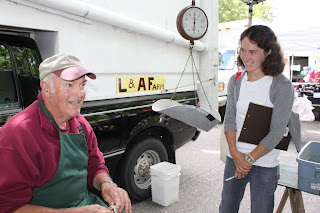
“I’m lost.” I say with a sigh. “I don’t think these have been picked.”
“What do you mean, not picked?” he asks me.
“There are still beans on them.” I say doubtfully.
“Nah.”
Pee Wee brushes past me and strides down the row; he is merely glancing at the plants below him as he moves. Stopping suddenly about twenty feet along, he bends to part the leaves of a plant at his knees.
“Here.” He says.
I shake my head. “How do you do that?”
In my final rotation on Jordan’s Farm, Penny has deliberately assigned me to work with The Guys as much as possible. I have tagged along in the fields, nervously wielded a hoe, and bumped about on the tailgate of the truck like Winnie-ther-Pooh on the stairs. I have harvested beets, cucumbers, the first of the season’s peppers and cherry tomatoes, and I have harvested beans. Lots of beans. Flat beans, amarillo, and green, green beans.
In the cucumber patch on Wednesday, in the heat, I find myself comparing this work with four jovial Puerto Rican men to the work I have done with the women at Broadturn. Here, I am generally just trying to keep up. Here, I am always trying to understand. And here, I am gently absorbing the wisdom of Pee Wee.
“What’s next, Pee Wee?”
“Cucumbers.”
“Same as yesterday?”
“No, the new ones. Have to be careful.”
Making our way through the rows, I can see what he means. We stomp straight across the rows of yesterday’s harvest – picked multiple times and succumbing now to weeds and rot. After six or eight rows we come to an expanse of vibrant and virile cucumber plants; these have broad, fresh leaves spilling across the rows and a look of being untouched. Pee Wee instructs me further that this time, the ripe fruit will be in the center of the plants, because the plants are young. “Take only the biggest ones.”
And this sets me to thinking, once again, about an awareness of life’s process. Somehow, never having gardened and knowing very little about plants, I always picture the strong, beautiful, and actively producing version of the plant. (Is this influenced in some way by our culture’s preoccupation with the “youth and beauty” phase of our own life process?) It affected me to fully realize that the cucumber does not go directly from strong and virile to dead. It continues to produce, only not as much and not as well. It begins to rot at one end while stubbornly creating new fruit at the other. And from the farmer’s perspective – less care is given once those plants have reached a certain point. One needn’t be so careful of accidentally treading upon the leaves; weeds are allowed to stake their claim upon shared ground. Fruit is harvested, but quickly. No time is wasted searching among the sub-par for the perfect fruit that likely is not there. The plant is no longer worth the extra work, but this transition is a gradual process.
On so many occasions this summer, I have felt a subtle expansion in my awareness of life cycles; in portions of conversation, in certain striking visions of bolted lettuces, in the endless repetition of particular physical actions I have noticed again and again – aha! This is life at work. In our Story Circle with the work share members at Broadturn last Tuesday, we asked what they see of the farm that the average CSA member does not. To clarify: work share members help to harvest once per week in exchange for their vegetables; most CSA members simply pay for a share and visit the farm each week to pick it up. The predominant answer we received: the dark side. The completeness and the complexity of the cycle. A paying CSA member won’t see the vegetables rotting in the fields, the eggplants destroyed by potato beetles, or the chicks that die in the night. Bea and Megan broadened this observation to say: without these experiences, one’s knowledge of the food is incomplete. Because of this, the perception of value attached to the food is different.

Work Share Story Circle at Broadturn Farm
Beyond simply expanding my recognition of life processes at work, the summer has taught me about the truth in cultivation: a practice of growing food for human consumption. A miniature example: I was harvesting cherry tomatoes at Broadturn Farm last week. Despite all efforts to the contrary, I discovered a large tomato hornworm munching his or her way across a vulnerable leaf. The protocol here is to snip the caterpillar in half with a pair of scissors. Shockingly green guzzles of hornworm innards can then be expected to erupt forth from the offending pest, bubbling their way toward earth as the worm’s legs wriggle through the throes of death. I asked Sam about the hornworm. A moth, she said. The moth lays her eggs in the tomato house; the soft green caterpillars are born, and they are poised for a delightful feast (they really like tomatoes). Caught between revulsion toward the hornworm’s insides and a sad appreciation for the beauty of the life it aspires to, I was momentarily immobilized. As I stood there with my open scissors arrested inches from the worm, my thoughts were something like: “Here is a life that I am choosing to end for the good of my own kind. Hornworms must be destroyed if I am to enjoy the fruit of the tomato plant; the interests of the hornworm are directly in conflict with mine.” It was the diminutive nature of this event that had the most profound effect on me. For I suddenly realized: every time I put anything in my mouth, every time I seek to sustain myself, I have at the very least killed a hornworm. The fact that I buy my tomatoes at the farm stand or the supermarket and never see the hornworm does not change the fact that legions of hornworms have been destroyed for my benefit. What was most striking was the realization that so many exchanges of this kind are part of my own sustenance, and for the most part I know nothing of them.
We can intellectually grasp the idea that our lives are built in relationship to others, and that we must kill and eat what was once alive in order to survive. To understand those relationships as a whole being, physically and mentally conscious, is another matter. There has been so much writing and reading in recent years about the divorce our society has created between the consumer and the sources of our food. Many people feel that if they had to kill a cow, they wouldn’t be able to eat it. But what John, and Stacy, and Bea had to say is that it is the Knowing that makes the whole process okay. By knowing the animal or the plant, by taking part in the process of choosing that life for mine, you take responsibility for yourself and for your natural place in the order of things. By adding your own labor to the equation, by working to protect the eggplant you will later eat, you are more likely to highly value that eggplant when you eat it.
Called up from vacant grasslands in the back of my mind, I glimpse the watered-down teachings of various Native American peoples as they were presented to me in early grade school. There is a picture here of a barefoot man kneeling by the deer he has just felled. Some words pass between the man and the deer in the final moments before all light passes from her visage. I don’t know the details, but I know that the man has said: “thank you”. As this image fades through my mind, I find another in its place: a family around a table with heads bowed at their plates. And so I wonder, in a culture divorced from knowledge of our food, what has happened to the mechanics and the rituals whereby we place our thanks? When we do take the time to say thank you, do we know what to be grateful for? Have we successfully abstracted our “thanks” to fit a weak understanding of the gift? Where now do we find the lesson: In knowing the sacrifice of our nourishment, may we aptly express our gratitude. In being truly grateful, may we humbly fulfill our purpose here on Earth?
















